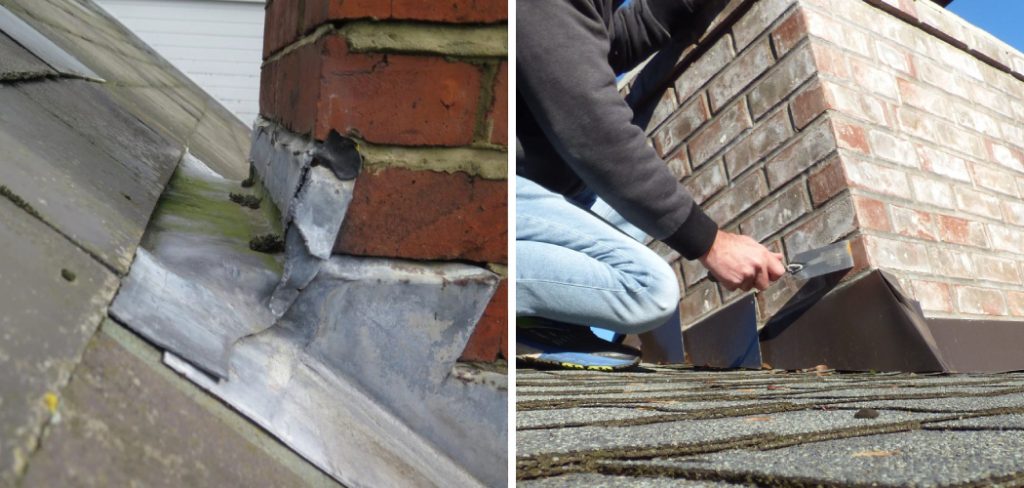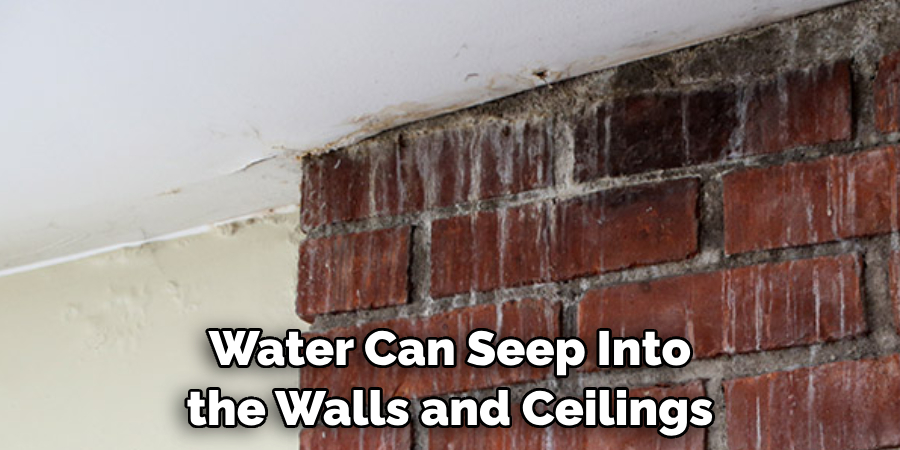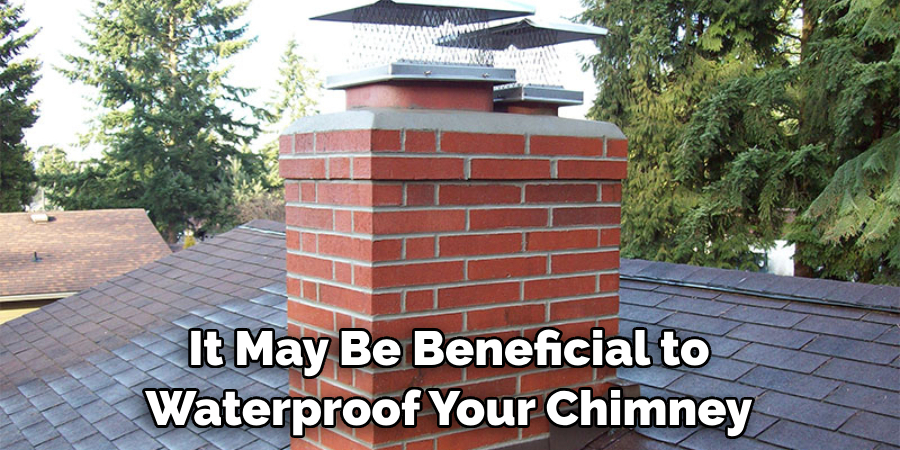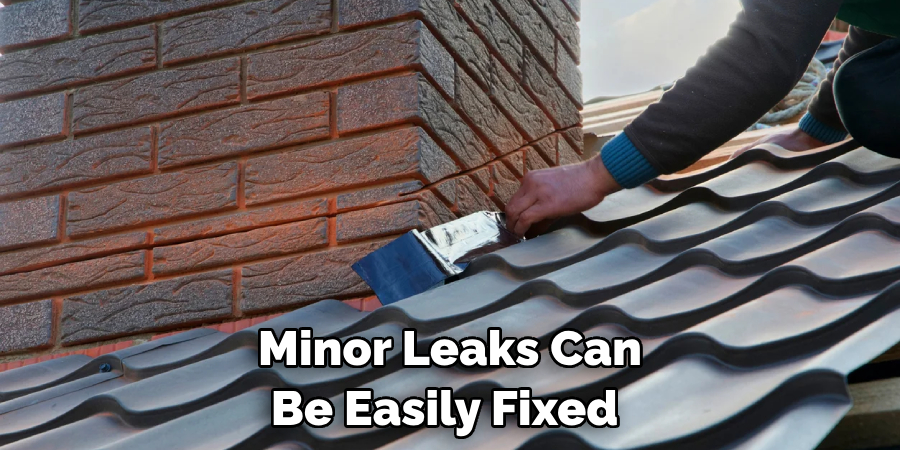The winter chill starts to sink in and all you want is a roaring fire inside your fireplace. Imagine the warmth on your face as you cozy up with friends and family – a perfect way to spend those cold evenings. But wait, what’s that sound? Is that water dripping down from the walls of the fireplace? You check closer only to discover something worse: there’s water coming down from above!

It looks like you have yourself a leaking fireplace. Not only can this cause damage to your décor, but it could also be hazardous if left unresolved. Don’t worry though, we are here to help guide you through the process of fixing it right away! Read on for more information about how to fix a leaking fireplace and prevent future problems from occurring.
What Causes a Leaking Fireplace?
1 . Damage to the Chimney Flashing
The flashing around the chimney is used to create a seal between the roof and the chimney. Over time, this flashing can become damaged due to exposure to weather elements such as wind, rain, and snow. This can lead to gaps or cracks that allow water to seep into your fireplace.
2 . Cracked Mortar Joints
Mortar joints are used to hold bricks together in a chimney structure. However, these joints can crack over time due to age or exposure to moisture. When this happens, water can enter through these cracks and cause leaks in your fireplace.

3 . Damaged Chimney Cap
Chimney caps are designed to prevent debris and animals from entering your chimney. However, these caps can become damaged or cracked, which allows water to enter and cause leaks in your fireplace.
4 . Faulty Flashing Installation
Improper installation of the flashing around your chimney can also lead to leaking. If the flashing is not installed correctly or is missing altogether, it leaves an opening for water to enter and cause damage to your fireplace.
5 . Damaged Chimney Crown
The chimney crown sits on top of the chimney and helps protect it from weather elements. Over time, this crown can become cracked or damaged due to exposure to extreme temperatures and moisture. This can allow water to seep into your fireplace and cause leaks.
Why is It Important to Fix a Leaking Fireplace?
1 . Prevent Structural Damage
A leaking fireplace can cause significant damage to the structure of your home. If left unfixed, water can seep into the walls and ceilings, leading to mold growth and weakening of the foundation. Over time, this could result in costly repairs or even compromise the safety of your home.

2 . Avoid Health Hazards
When water enters the home through a leaking fireplace, it creates an ideal environment for mold and mildew to grow. These fungi can trigger allergic reactions and respiratory problems such as asthma attacks. It is essential to fix a leaking fireplace promptly to prevent any health hazards for you and your family.
3 . Increase Energy Efficiency
A leaking fireplace can also lead to drafts in your home, making it difficult to maintain a consistent temperature. This can result in higher energy bills as your heating system works harder to compensate for the cold air entering your home. By fixing a leaking fireplace, you can improve the energy efficiency of your home and save money on utility costs.
4 . Preserve the Value of Your Home
A well-maintained home will hold its value better than one with neglected repairs. A leaking fireplace is not only an eyesore, but it can also lead to more severe issues if left untreated. By fixing the leak, you are preserving the value of your home and ensuring that it remains in good condition for years to come.
5 . Prevent Fire Hazards
In addition to water damage, a leaking fireplace can also pose a fire hazard. If water leaks onto the gas line or electrical components of the fireplace, it could potentially ignite a fire. It is crucial to fix any leaks and ensure that your fireplace is functioning safely.
12 Tips on How to Fix a Leaking Fireplace
1 . Identify the Source of the Leak
The first step in fixing a leaking fireplace is to identify where the leak is coming from. This will help determine what type of repair is needed and how extensive it may be. This will also prevent any unnecessary repairs or expenses.
2. Check the Chimney Cap
The chimney cap is designed to keep rain and snow from entering the flue and causing leaks. If the cap is damaged or missing, it can allow water to enter the fireplace. Make sure your chimney cap is in good condition and replace if necessary.
3. Inspect the Flashing
Flashing is a metal strip that seals the gap between the roof and chimney to prevent water from entering. Over time, flashing can become loose or damaged, allowing water to leak into the fireplace. Check for any gaps or damage and repair as needed.
4. Clean out Gutters
Clogged gutters can cause water to overflow onto your roof, which can then seep into your chimney and fireplace. Make sure to regularly clean out your gutters to prevent any potential leaks.

5. Seal Cracks in Masonry
If the bricks or mortar around your fireplace are cracked, this can also allow water to enter. Use a waterproof masonry sealant to fill in any cracks and prevent further leaks.
6. Check for Condensation
Sometimes, the leak may not be caused by external factors but rather condensation buildup inside the flue. This can occur when warm air from the house meets cold air from outside, creating moisture that drips down into the fireplace. Installing a flue liner can help prevent this issue.
7. Install a Chimney Cap with Mesh
If birds or other animals are entering your chimney, they may also be bringing in twigs and debris that can cause blockages and leaks. Installing a chimney cap with mesh will prevent any critters from entering.
8. Fix Damaged Chimney Crown
The chimney crown is the top cement layer on top of the chimney that seals out water and protects the bricks underneath. If this becomes damaged, it can allow water to enter. Repair or replace your chimney crown as needed.
9. Replace Damaged Bricks or Mortar
If you notice any damaged bricks or mortar around your fireplace, it’s important to repair them promptly to prevent further damage and leaks. You can hire a professional mason or do it yourself if you have experience.
10. Check for a Damaged Chimney Liner
The chimney liner is designed to protect the flue and prevent leaks, but over time it can become damaged or corroded. If you suspect your chimney liner is the source of the leak, it’s important to have it inspected and replaced if necessary.
11. Clean Your Chimney Regularly
A buildup of creosote and debris in your chimney can cause damage and lead to leaks. Make sure to clean your chimney at least once a year to prevent any potential issues. Also, make sure to have a professional chimney sweep do the job for safety and efficiency.
12. Consider Waterproofing
If you live in an area with frequent rain or snow, it may be beneficial to waterproof your chimney. This will help prevent any future leaks and protect the structure of your fireplace. You can hire a professional or purchase a waterproofing sealant yourself.

Frequently Asked Questions
What Precautions Should I Take to Avoid a Leaking Fireplace?
When it comes to fireplaces, prevention is always better than cure. Here are some precautions you can take to avoid a leaking fireplace:
- Regularly inspect your chimney for any cracks or damage.
- Keep the area around your fireplace clean and free from debris.
- Make sure your chimney cap is securely in place to prevent water from entering.
- Seal any gaps or holes in the chimney or roof near the chimney.
- Have your fireplace professionally inspected and cleaned at least once a year.
What Are Some Common Causes of Leaking Fireplaces?
There are various reasons why your fireplace might be leaking. The most common causes include:
- Damaged chimney cap or crown
- Cracks in the chimney structure
- Poor installation of flashing around the chimney
- Damaged or missing mortar between bricks
How Can I Identify a Leaking Fireplace?
Aside from seeing visible water leaks, there are a few signs that can indicate your fireplace is leaking:
- Musty smells near the fireplace
- Water stains on ceilings or walls near the fireplace
- Dampness or discoloration on the walls surrounding the fireplace
If you notice any of these signs, it’s important to address the issue promptly to prevent further damage.
Can I Fix a Leaking Fireplace Myself?
While some minor leaks can be easily fixed by homeowners, it’s always best to hire a professional for any chimney and fireplace repairs. They have the necessary expertise and equipment to properly identify the cause of the leak and fix it effectively.

What Steps Should I Take If My Fireplace Is Already Leaking?
If you notice that your fireplace is leaking, here are some steps you can take:
- Stop using the fireplace immediately.
- Identify the source of the leak.
- Clear any debris or obstructions from your chimney.
- Seal any cracks or gaps in the chimney structure.
- Call a professional for an inspection and repair if needed.
Can I Prevent Future Leaks After Fixing My Fireplace?
Yes, there are steps you can take to prevent future leaks after fixing your fireplace:
- Have your chimney regularly inspected and maintained by a professional.
- Keep the area around your fireplace clean and free from debris.
- Make sure your chimney cap is securely in place.
- Address any cracks or damage to the chimney structure promptly.
By following these precautions, you can reduce the risk of another leaking fireplace in the future. Remember, proper maintenance is key to keeping your fireplace functioning effectively and preventing costly repairs down the line. So, be sure to take care of your fireplace regularly to avoid any potential problems, including leaks.
How Much Will It Cost to Fix a Leaking Fireplace?
The cost of fixing a leaking fireplace can vary depending on the extent of the damage and the necessary repairs. It’s best to get a professional assessment and quote for an accurate estimate. However, investing in timely repairs can save you from more extensive and expensive repairs in the future.
So, it’s important not to ignore any signs of a leaking fireplace and address them promptly before they worsen. Overall, taking care of your fireplace will ensure its longevity and prevent any potential leaks that could cause damage to your home.
Can I Use a Waterproof Sealant to Fix a Leaking Fireplace?
While waterproof sealants can temporarily fix minor leaks, they are not a permanent solution. It’s important to identify and address the root cause of the leak for proper and long-lasting repairs. Additionally, using inappropriate sealants or materials can do more harm than good and may even cause further damage to your fireplace. Therefore, it’s always best to consult a professional for any fireplace repairs to avoid causing more extensive and costly damage in the long run. Overall, investing in professional services is worth it for the safety and longevity of your fireplace.

Conclusion
A leaking fireplace can cause damage and be a nuisance, but with these tips, you can identify and fix the issue efficiently. Remember to always prioritize safety and consult a professional if needed. Regular maintenance and repairs will not only prevent leaks but also ensure the longevity of your fireplace.
Now you know how to fix a leaking fireplace! Don’t let a minor leak turn into a major problem – take action as soon as you notice any signs of a leak. So, it’s important to regularly maintain and inspect your fireplace to identify and fix any potential issues before they become larger problems. With these tips in mind, you can keep your fireplace in tip-top shape and enjoy cozy fires without worrying about leaks. Remember, when in doubt, always consult a professional for assistance with repairs or maintenance.
